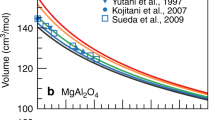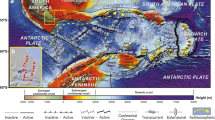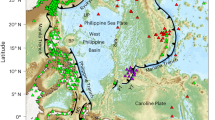Abstract
Knowledge of the rate of plate-spreading at mid-ocean ridges is critical for estimating plate motions1 and the outward flux of heat from Earth’s interior2,3,4. Magnetic lineations5 and anisotropy—crystals that have aligned themselves with mantle flow—preserved in oceanic lithosphere provide a means for estimating plate-spreading rates up to 180 million years ago. However, reconstructions beyond this time are difficult because most older oceanic lithosphere has been subducted into the mantle. Here we use converted seismic waveforms to show that anisotropy is preserved in the subducted part of the Cocos Plate beneath Central Mexico. We observe strong P- and S-wave anisotropy in the topmost 2–6 km of the subducted oceanic mantle. The strength of the anisotropy is comparable to that measured in the surface portion of the Cocos Plate6. We also show that P-wave azimuthal anisotropy and plate-spreading rate at present-day mid-ocean ridges exhibit a linear relationship. On the basis of this relationship, we suggest that the subducted portion of the Cocos Plate formed at a half-spreading rate of about 8 cm yr−1 at the East Pacific Rise, about 15 million years ago. Our results imply that subducted oceanic lithosphere could preserve an archive of ancient plate-spreading rates on Earth.
This is a preview of subscription content, access via your institution
Access options
Subscribe to this journal
Receive 12 print issues and online access
$259.00 per year
only $21.58 per issue
Buy this article
- Purchase on Springer Link
- Instant access to full article PDF
Prices may be subject to local taxes which are calculated during checkout




Similar content being viewed by others
References
DeMets, C., Gordon, R. G. & Argus, D. F. Geologically current plate motions. Geophys. J. Int. 181, 1–80 (2010).
Becker, T. W., Conrad, C. P., Buffet, B. & Muller, R. D. Past and present seafloor age distribution and temporal evolution of plate tectonic heat transport. Earth Planet. Sci. Lett. 278, 233–242 (2009).
Labrosse, S. & Jaupart, C. Thermal evolution of the Earth: Secular changes and fluctuations of plate characteristics. Earth Planet. Sci. Lett. 260, 465–481 (2007).
Korenaga, J. Archean Geodynamics and Environments Vol. 164, 7–32 (AGU Monograph Series, AGU, 2006).
Muller, R. D., Sdrolias, M., Gaina, C. & Roest, W. R. Age, spreading rates and spreading symmetry of the world’s ocean crust. Geochem. Geophys. Geosys. 9, Q04006 (2008).
Sndysman, W. E., Lewis, B. T. R. & McClain, J. Upper mantle velocities on the northern Cocos plate. Earth Planet. Sci. Lett. 28, 46–50 (1975).
Toomey, D. R., Jousselin, D., Dunn, R. A., Wilcock, W. S. D. & Detrick, R. S. Skew of mantle upwelling beneath the East Pacific Rise governs segmentation. Nature 446, 409–414 (2007).
Gaherty, J. B., Lizarralde, D. L., Collins, J., Hirth, G. & Kim, S. Mantle deformation during slow seafloor spreading constrained by observations of seismic anisotropy in the western Atlantic. Earth Planet. Sci. Lett. 228, 255–265 (2004).
Shinohara, M. et al. Upper mantle and crustal seismic structure beneath the northwestern Pacific basin using a seafloor broadband seismometer and ocean bottom seismometers. Phys. Earth Planet. Inter. 170, 95–106 (2008).
Oikawa, M., Kaneda, K. & Nishizawa, A. Seismic structures of the 154–160 Ma oceanic crust and uppermost mantle in the northwest Pacific Basin. Earth Planets Space 62, E13–E16 (2010).
Park, J. & Levin, V. Seismic anisotropy: Tracing plate dynamics in the mantle. Science 296, 485–489 (2002).
Christensen, N. I. The magnitude, symmetry and origin of upper mantle anisotropy based on fabric analyses of ultramafic tectonites. Geophys. J. R. Astr. Soc. 76, 89–111 (1984).
Ismail, W. B. & Mainprice, D. An olivine fabric database: an overview of upper mantle fabrics and seismic anisotropy. Tectonophysics 296, 145–197 (1998).
Calvert, A. J., Sawyer, E. W., Davis, W. J. & Ludden, J. N. Archaean subduction inferred from seismic images of a mantle suture in the Superior Province. Nature 375, 670–674 (1995).
Cook, F., van der Velden, A. J., Hall, K. W. & Roberts, B. J. Frozen subduction in Canada’s northwest territories: Lithoprobe deep lithospheric reflection profiling of the western Canadian shield. Tectonics 18, 1–24 (1999).
Van der Velden, A. J. & Cook, F. Relict subduction zones in Canada. J. Geophys. Res. 110, B08403 (2005).
Bostock, M. G. Anisotropic upper-mantle stratigraphy and architecture of the Slave craton. Nature 390, 392–395 (1997).
Mercier, J-P. et al. The teleseismic signature of fossil subduction: Northwestern Canada. J. Geophys. Res. 113, B04308 (2008).
Masacchio, G., White, D. J., Asudeh, I. & Thomson, C. J. Lithospheric structure and composition of the Archaean western Superior Province from seismic refraction/wide-angle reflection and gravity modelling. J. Geophys. Res. 109, B03304 (2004).
Kim, Y., Clayton, R. W. & Jackson, J. M. Geometry and seismic properties of the subducting Cocos plate in central Mexico. J. Geophys. Res. 115, B06310 (2010).
Song, T-R. A. et al. Subducting slab ultra-slow velocity layer coincident with silent earthquake in southern Mexico. Science 324, 502–506 (2009).
Helmberger, D. V. & Vidale, J. Modeling strong motions produced by earthquakes with two-dimensional numerical codes. Bull. Seismol. Soc. Am. 78, 109–121 (1988).
Shor, G. G. & Fisher, R. L. Middle America trench: Seismic refraction studies. Geol. Soc. Am. Bull. 72, 721–729 (1961).
Levin, V. & Park, J. P-SH conversions in layered media with hexagonally symmetric anisotropy: A cookbook. Pure Apply. Geophys. 151, 669–697 (1998).
Frederiksen, A. W. & Bostock, M. G. Modeling teleseismic waves in dipping anisotropic structures. Geophys. J. Int. 141, 401–402 (2000).
Cassidy, J. F. Numerical experiments in broadband receiver function analysis. Bull. Seismol. Soc. Am. 82, 1453–1474 (1992).
Karato, S., Jung, H., Katayama, I. & Skemer, P. Geodynamic signatures of seismic anisotropy of the upper mantle: New insights from laboratory studies. Annu. Rev. Earth Planet. Sci. 36, 59–95 (2008).
Manea, V. & Gurnis, G. Subduction zone evolution and low viscosity wedges and channels. Earth Planet. Sci. Lett. 264, 22–45 (2007).
Pardo, M. & Suarez, G. Shape of the subducted Rivera and Cocos plates in southern Mexico, seismic and tectonic implications. J. Geophys. Res. 100, 12357–12373 (1995).
Currie, C. A., Hyndman, R. D. & Wang, K. Thermal models of the Mexico subduction zone: Implications for the megathrust seismogenic zone. J. Geophys. Res. 107, 2370 (2002).
Acknowledgements
We are grateful to the Incorporated Research Institutions for Seismology Data Management Center (IRIS-DMC) for making the data available. We thank A. Federiksen and M. Bostock for providing software for calculating receiver functions through dipping anisotropic layers, and H. Kawakatsu, P. Asimow and S. O’Reilly for the comments on lithospheric anisotropy, ophiolite assemblages and cratonic lithosphere formation during the early stage of this work. We acknowledge the MASE team for making the data available. We also thank D. Anderson and P. D. Asimow for help in reviewing an early draft of this paper. This study is supported by the Institute for Research on Earth Evolution (IFREE), Japan Agency for Marine-Earth Science and Technology (JAMSTEC) and the Tectonic Observatory at Caltech.
Author information
Authors and Affiliations
Contributions
T-R.A.S. initiated the project and carried out local waveform modelling. T-R.A.S. and Y.K. carried out receiver function analysis and modelling. T-R.A.S. and Y.K. wrote the manuscript.
Corresponding author
Ethics declarations
Competing interests
The authors declare no competing financial interests.
Supplementary information
Supplementary Information
Supplementary Information (PDF 8845 kb)
Rights and permissions
About this article
Cite this article
Song, TR., Kim, Y. Anisotropic uppermost mantle in young subducted slab underplating Central Mexico. Nature Geosci 5, 55–59 (2012). https://doi.org/10.1038/ngeo1342
Received:
Accepted:
Published:
Issue Date:
DOI: https://doi.org/10.1038/ngeo1342
This article is cited by
-
Large-scale variation in seismic anisotropy in the crust and upper mantle beneath Anatolia, Turkey
Communications Earth & Environment (2021)
-
Active-source seismic survey on the northeastern Hawaiian Arch: insights into crustal structure and mantle reflectors
Earth, Planets and Space (2018)
-
Internal deformation of the subducted Nazca slab inferred from seismic anisotropy
Nature Geoscience (2016)
-
Seismic Anisotropy and Mantle Flow Driven by the Cocos Slab Under Southern Mexico
Pure and Applied Geophysics (2016)
-
Effect of hydration on the elasticity of mantle minerals and its geophysical implications
Science China Earth Sciences (2016)



